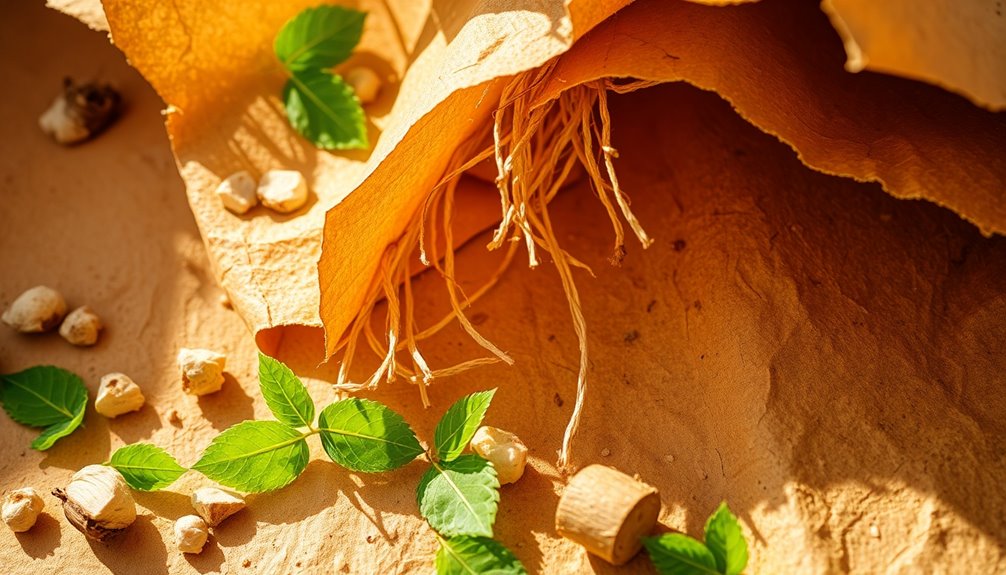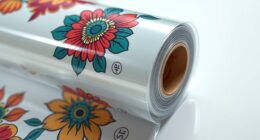Kraft paper's made primarily from wood pulp, thanks to a unique manufacturing process that creates a strong and versatile product. In this process, softwood is cooked in an alkaline solution, which separates lignin from cellulose fibers. This enhances its tensile strength, making it perfect for various applications. You'll often find brown kraft paper, sack kraft paper, and absorbent kraft paper, each suited for specific uses. Plus, kraft paper is recyclable and promotes sustainability. If you're curious about its numerous applications and benefits, there's plenty more to discover about this eco-friendly material.
Key Takeaways
- Kraft paper is primarily made from wood pulp, which provides its strength and durability.
- The manufacturing process involves cooking wood chips in an alkaline solution to separate lignin and cellulose fibers.
- Softwood is typically used for its long fiber strength, enhancing the paper's tensile properties.
- Kraft paper can incorporate recycled materials, promoting reduced chemical usage in production.
- It is available in various weights and thicknesses to suit different applications and uses.
Definition and Origin

Kraft paper, often recognized for its strength and versatility, originates from the kraft process, which transforms wood chips into durable paper. This process involves chemically treating wood pulp to separate lignin from cellulose fibers, resulting in a product that boasts impressive tensile strength. The term "kraft" itself comes from a German word meaning "strength," aptly reflecting the durable properties of this paper.
By minimizing the lignin content, the kraft process produces a stronger pulp compared to methods like acidic sulfite or mechanical pulping. This strength enables kraft paper to withstand various stresses, making it an ideal choice for packaging material.
You'll find kraft paper available in various weights and thicknesses, allowing you to select the right type for any application, from wrapping delicate items to providing robust support for heavier goods.
It's essential to distinguish kraft paper from paper craft; the former is a strong packaging material, while the latter relates to artistic uses of paper.
With its coarse texture and reliable performance, kraft paper has become a staple in both commercial and personal projects.
Manufacturing Process
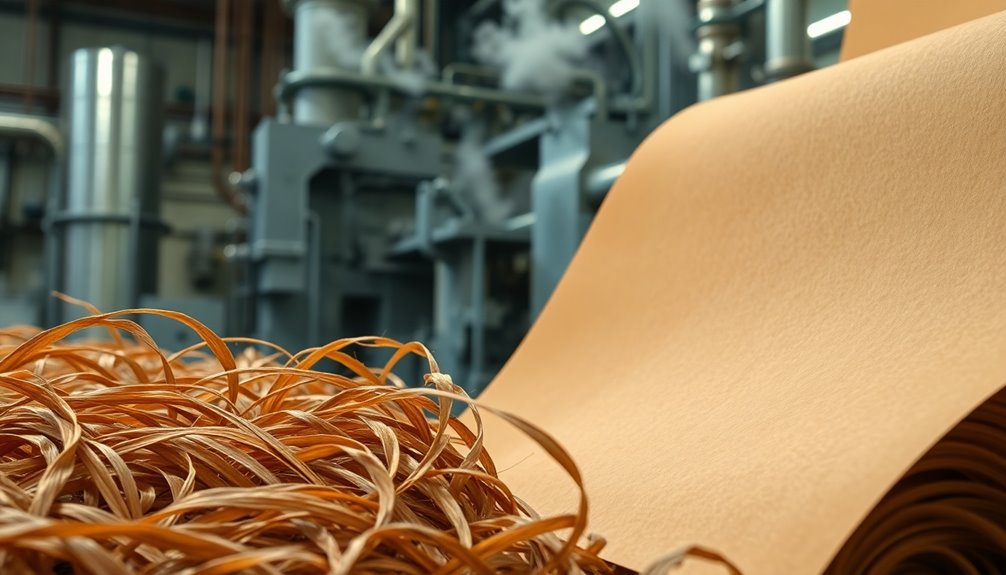
The manufacturing process of kraft paper is a fascinating blend of chemistry and engineering that transforms raw wood into a highly durable material.
Kraft paper is made through the kraft process, which involves cooking wood chips in an alkaline solution. This method breaks down lignin and separates cellulose fibers, converting wood into wood pulp. Softwood is primarily used for kraft paper production because its long fibers contribute to the paper's high strength and durability.
After cooking, the resulting pulp is washed and screened to remove impurities. It can then be bleached and dried into sheets of kraft paper. This process allows for the incorporation of recycled materials, which require fewer chemicals than initial production, making it more environmentally friendly.
Kraft paper can be produced in various thicknesses and textures, catering to different applications and performance requirements.
Whether you need strong packaging products with high durability or specific textures for unique uses, the kraft process guarantees that you get a versatile and reliable material. This adaptability makes kraft paper a popular choice across multiple industries.
Qualities and Types
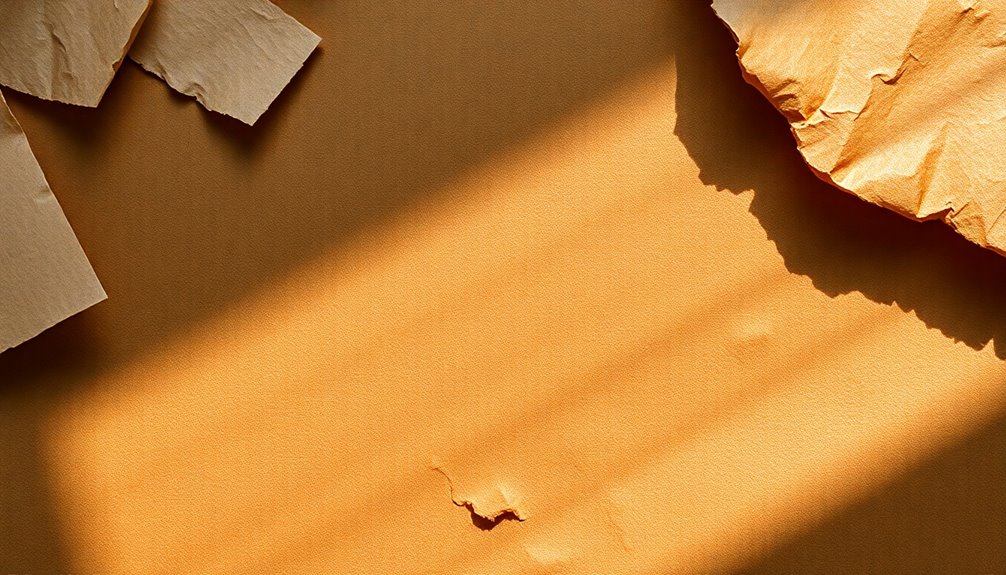
When it comes to kraft paper, its qualities and types play an essential role in determining the right fit for your needs. Kraft paper is made primarily from wood pulp, giving it a coarse texture and high tensile strength, making it perfect for various packaging applications.
You'll find different types of kraft paper, each tailored for specific uses. Brown kraft paper stands out for its durability and strength, while sack kraft paper is designed for high elasticity and exceptional tear resistance. This makes it ideal for packaging bulk goods such as cement and flour.
If moisture absorption is vital for your project, absorbent kraft paper features controlled porosity, ensuring uniformity in absorption. Another specialized option is spinning kraft paper, which emphasizes strength in the machine direction and elongation, suitable for high-performance packaging.
Additionally, hunting cartridge paper combines high tensile strength with elongation, effectively holding cartridges during use. Understanding these qualities and types of kraft paper helps you select the best option for your specific applications, ensuring peak performance and satisfaction.
Applications and Uses
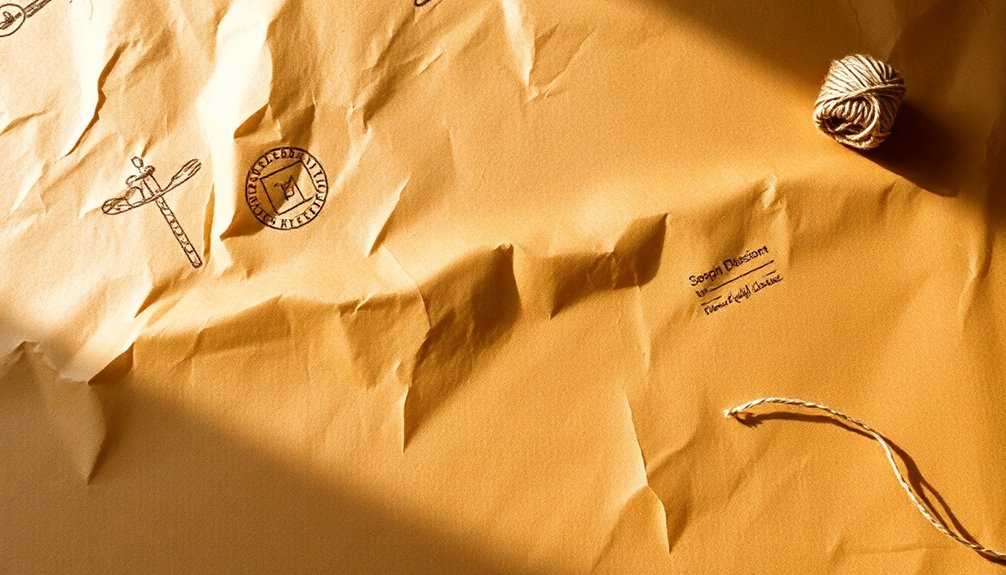
When you think about kraft paper, packaging solutions likely come to mind first, given its strength and durability.
It's not just for shipping; you can also get creative with it in arts and crafts projects.
Plus, using kraft paper has environmental benefits, making it a smart choice for both personal and industrial applications.
Packaging Solutions
Kraft paper stands out as a top choice for packaging solutions, thanks to its impressive strength and durability. You'll find it extensively used in multiwall bags for cement, flour, and various food products. Its high strength makes it ideal for safely transporting goods without tearing or breaking.
Plus, kraft paper provides an environmentally friendly alternative for e-commerce shipping, as it's lightweight and can be easily customized for branding, helping you stand out.
In the food industry, kraft paper is favored for food packaging because it complies with safety regulations and helps minimize plastic waste, making it a smart choice for sustainability.
Its high durability also allows for versatile applications, from protective coverings in construction to insulation materials, showcasing its robust nature.
When you think of kraft paper, consider how it meets both practical and ecological needs. Whether you're shipping products or packaging food, using recycled kraft paper supports a greener planet.
Arts and Crafts
Beyond its impressive packaging capabilities, kraft paper shines in the domain of arts and crafts. Its natural strength and coarse texture make it an excellent choice for a variety of projects, including scrapbooking and gift wrapping. You'll find that its durable nature allows you to create decorative items like table runners, banners, and party decorations that stand out.
Kraft paper is also customizable; you can easily enhance it with stamps, paints, and other embellishments, making it a versatile medium for your artistic expression. Whether you're working on a DIY project or planning a classroom activity, its affordability and availability in different weights and colors make it a go-to option.
For those of you who care about the environment, you'll appreciate that kraft paper is eco-friendly and biodegradable. This means you can enjoy your arts and crafts while being mindful of sustainability.
Environmental Benefits
Embracing the environmental benefits of kraft paper can lead to a more sustainable lifestyle. Made from renewable wood pulp, kraft paper supports sustainable forestry practices and reduces reliance on non-renewable resources in various packaging applications.
Its biodegradability allows it to decompose naturally, greatly contributing to reduced landfill waste and promoting a circular economy.
You'll be pleased to know that the recycling rate for kraft paper bags has improved dramatically, rising from 20.1% in 2000 to 37.6% in 2008. This trend showcases a growing commitment to sustainable practices in paper usage.
Plus, kraft paper's versatility makes it an excellent choice for a wide range of applications, including food packaging, e-commerce, and industrial products. By utilizing kraft paper, you can effectively replace plastic alternatives, reducing your overall environmental impact.
The production of kraft paper also generates less pollution compared to plastics, fostering eco-friendly packaging solutions that are better for our planet.
Environmental Considerations
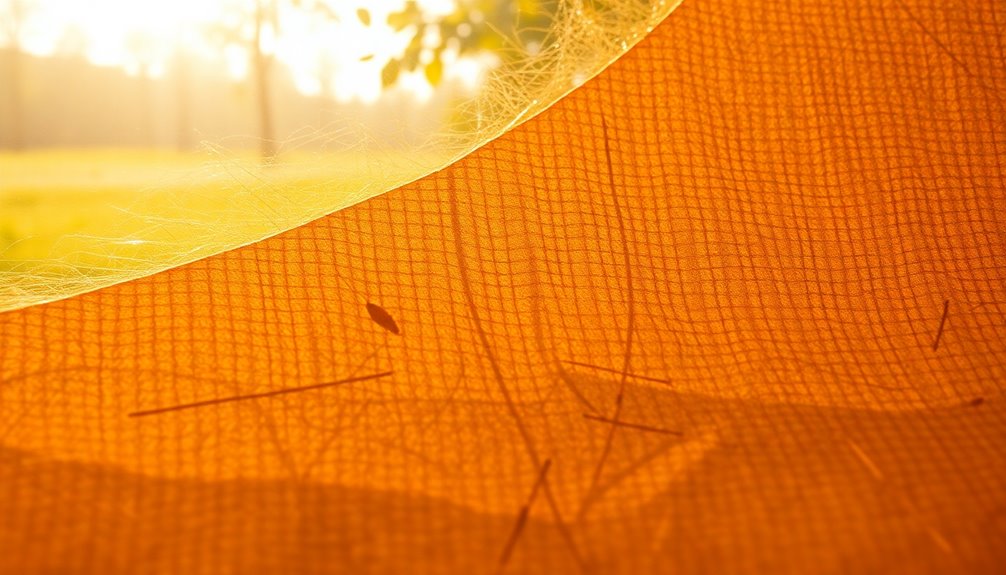
When you choose kraft paper, you're opting for a product that's both recyclable and biodegradable, making it an eco-friendly choice.
Its production supports sustainable resource utilization, helping to preserve our forests.
Plus, kraft paper's lower environmental impact compared to plastic alternatives is a win for the planet.
Recyclability and Biodegradability
Recognizing the environmental benefits, kraft paper stands out as a sustainable alternative to plastic packaging due to its 100% recyclability and biodegradability.
When you choose kraft paper, you're opting for an eco-friendly solution that reduces waste and supports a healthier planet. The production process utilizes renewable resources, promoting sustainable forestry practices and minimizing the overall environmental impact.
While kraft paper itself is recyclable, it's important to be aware that certain coatings, like polyethylene, may hinder its recyclability.
This means that when designing products, careful consideration of materials is essential. Innovations in kraft paper manufacturing, such as the development of zein coatings, aim to enhance recyclability while maintaining necessary moisture resistance.
Sustainable Resource Utilization
Sustainable resource utilization is at the heart of kraft paper production, as it relies on renewable wood pulp sourced from responsibly managed forests. By using wood pulp derived from softwood species, kraft paper supports sustainable forestry practices that guarantee forests remain healthy and productive. This renewable resource helps reduce the environmental impact compared to traditional paper products.
The kraft process enhances resource efficiency by minimizing waste and allowing for the recycling of chemicals used during production. As a result, a significant portion of kraft paper products, like bags and folding cartons, are recycled. In fact, by 2008, approximately 37.6% of kraft paper bags and 35.2% of folding cartons in the U.S. had been recycled, highlighting a growing trend toward sustainability.
Moreover, the incorporation of non-wood fibers in kraft paper production opens doors to alternative sustainable materials, further promoting eco-friendly practices. With consumer demand shifting towards greener options, kraft paper stands out as an excellent choice.
Reduced Environmental Impact
Kraft paper prominently cuts down on environmental impact, making it a smart choice for eco-conscious consumers. By choosing kraft paper, you support sustainable forestry practices through its production from renewable wood pulp. This not only conserves resources but also promotes an eco-friendly approach.
Here are some key benefits of using kraft paper:
- 100% recyclable: You can easily recycle kraft paper, minimizing waste.
- Biodegradable: It breaks down naturally, reducing landfill contributions.
- Lower pollution: The kraft production process generates less pollution than plastic manufacturing.
- Supports a circular economy: Utilizing kraft paper fosters a sustainable system that reuses materials.
As consumer demand for eco-friendly packaging rises, the shift toward kraft paper helps considerably reduce plastic waste in the environment.
Innovations like incorporating non-wood fibers and environmentally friendly coatings further enhance its sustainability and recyclability.
Printing and Customization Options

When it comes to printing and customizing kraft paper, you'll find a variety of methods at your disposal, including silk-screen, laser, and inkjet printing. Lighter-colored kraft yields better results for color vibrancy, making it ideal for your high-quality printed graphics and designs. The porous texture of kraft paper allows for excellent ink absorption, ensuring sharp and clear images.
Customization options for kraft paper are extensive, with various weights and thicknesses available to meet your specific needs. You can choose finishes like glossy or matte to enhance your designs further, catering to diverse branding and packaging requirements. Many brands utilize printed kraft paper not only for its aesthetic appeal but also to promote messages of eco-friendliness and sustainability.
Before committing to a large print run, it's wise to test print compatibility on the specific kraft paper you plan to use, as results can vary based on the printing technology and paper type.
Frequently Asked Questions
What Is the Difference Between Kraft Paper and Regular Paper?
Kraft paper and regular paper differ mainly in strength and texture.
When you handle kraft paper, you'll notice its rough, fibrous surface, making it more durable for heavy-duty tasks like packaging. Regular paper feels smoother but isn't as strong, which is why it's better for lighter uses like printing.
The unbleached nature of kraft paper gives it a characteristic brown color, while regular paper is usually white due to bleaching.
What Are Kraft Paper Made Of?
Kraft paper's strength comes from its unique composition.
It's primarily made from wood pulp, particularly from softwood trees, which provide long, strong fibers.
During production, you cook wood chips with alkaline chemicals to break down lignin and extract cellulose fibers. This process results in a pulp with low lignin content, enhancing the paper's durability.
You might also find non-wood fibers used, expanding the materials that can create this versatile paper.
Is Kraft Paper Eco-Friendly?
Yes, kraft paper is definitely eco-friendly.
It's made from renewable wood pulp, which supports sustainable forestry practices. You'll find that its production generates less pollution than plastic, making it a greener choice.
Plus, kraft paper is biodegradable and recyclable, helping to reduce landfill waste.
With innovations like non-wood fibers and eco-friendly coatings, you can feel good about using kraft paper in your packaging, contributing to a healthier planet.
Is Kraft Paper Chemical Free?
Kraft paper isn't entirely chemical-free. While it's derived from wood pulp, the kraft process uses alkaline chemicals to separate fibers, which can leave a chemical footprint.
However, many manufacturers focus on sustainability and employ methods like oxygen bleaching to minimize harmful substances.
You can find kraft paper that's produced with an emphasis on reducing chemical use, making it a more eco-friendly option compared to other types of paper.
Conclusion
To sum up, Kraft paper, made primarily from wood pulp, offers a strong and versatile solution for various applications. Its manufacturing process highlights its durability and eco-friendliness, while its wide range of qualities and types cater to different needs. You can easily find Kraft paper suited for everything from packaging to arts and crafts. Plus, with customization options available, it's a fantastic choice for both practical and creative projects. Embrace Kraft paper for your next endeavor!

